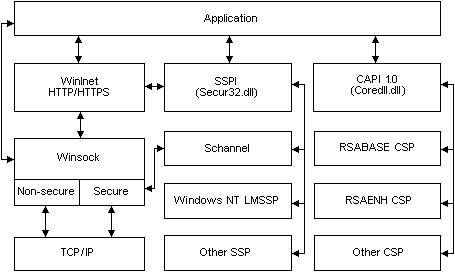
Windows CE supports secure socket connections through Winsock and WinInet. For more information on secure sockets, see Windows Sockets and Internet Connections.
Windows CE also supports the Microsoft Cryptographic API (CAPI) and Security Support Provider Interface (SSPI) for secure communication. The following illustration shows the relationship between these elements and your application.

The cryptographic functions supported in Windows CE exist as an integral part of CAPI. Services provided by these functions enable you to add encryption to your Windows CE–based application without requiring extensive knowledge of cryptography.
The algorithms and standards used by CAPI are implemented through cryptographic service providers (CSPs). CAPI functions are available through the Coredll.dll module.
SSPI provides a common interface between transport-level applications and security providers. It provides a mechanism by which a transport application can call one of several security providers and obtain an authentic connection without knowing the details of the security protocol. Security providers included with Windows CE: Windows NT® LAN Manager (NTLM), Secure Sockets Layer (SSL) version 2.0; SSL version 3.0; and Private Communication Technology (PCT) version 1.0 are provided through the Schannel Cryptographic Provider. The Schannel Cryptographic Provider is accessed through Winsock. Security Support Provider Interface (SSPI) functions are available through the Secur32.dll module.
For more information about CAPI and SSPI features available for Windows CE, see Security Support Provider Interface and Cryptography.